Jun 21 2018
Empa researcher Sebastian Siol is searching for novel materials that have extraordinary properties, but so far that had continued to be inaccessible in experiments.
 Claudia Cancellieri and Sebastian Siol are investigating heterostructural alloys at Empa's Laboratory for Joining Technologies and Corrosion (Image credit: Empa)
Claudia Cancellieri and Sebastian Siol are investigating heterostructural alloys at Empa's Laboratory for Joining Technologies and Corrosion (Image credit: Empa)
To achieve this, he links partners who actually don't fit together—one partner is forced by the other into a state, which without the dubious pairing, would be impossible to achieve. In additional, Siol ensures that the crystal bonds are able to last in daily life, because only then they can be applied to industrial applications.
A mixture of several metals is usually referred to as alloys. Yet, it is also possible to alloy other materials. For example, in the semiconductor sector, nitride and oxide alloys have been successfully used for a long time to modify the functional properties of the material. These changes often take place slowly and the base materials’ properties can still be recognized easily.
Conversely, “heterostructural alloys” are formed when compounds with completely different crystal structures are mixed together. In these types of alloys, changes occur in the structure based on the components’ mixing ratio. At times, this produces unexpected properties, which considerably differ from the properties of the base materials. These oxide alloys are the one Siol is actually interested in. In addition to discovering them, he wants to make these alloys practical for daily life. In his search to discover the required material, he has to look out for a number of material properties simultaneously, for example, the electronic properties, the structure, and the long-term stability.
Before joining Empa last year, Siol performed a study at the National Renewable Energy Research Laboratory (NREL) based in Golden, Colorado, where he made a prominent publication: alloys with “negative pressure”. With the help of his colleagues, Siol combined manganese telluride and manganese selenide using a cold-steam method called magnetron sputtering. At some ratios, the base materials formed a crystal lattice by combining together, but this lattice was “uncomfortable” for both components. It was observed that neither of the partners was able to force its preferred crystal structure, which it favors in a pure state, upon the other.
The ensuing compromise was a novel phase, which usually would form only at “negative pressure” – that is, when the material is eternally subjected to tension. It is very difficult to produce these materials under normal conditions. At NREL, Siol and his coworkers were able to overcome this challenge. Thanks to this method, the novel material is now accessible and exhibits many useful properties. For example, it is piezoelectric which means it can be utilized to produce detectors, generate electricity, or perform semiconductor experiments, which would not have been achieved if pure base materials had been used.
Researching Stable Systems
At Empa, Siol will lend his expertise in developing “impossible” oxide alloys. His goal is to find oxide mixtures that have a variable structure and therefore stabilize them in such a way that they can be used for everyday applications. Headed by Lars Jeurgens, the Laboratory for Joining Technologies & Corrosion has a considerable amount of know-how in practical applications for stable oxide alloys and oxide layers. Mixed oxides made of tungsten and titanium oxides are the initial focus and these could prove useful for sensor technology, window coatings, or semiconductor technology. Claudia Cancellieri, Siol’s colleague, has been studying the electronic properties of oxide interfaces for a number of years and adds her know-how to the project.
“The material combination is very exciting”, explains Siol. Titanium oxides are very stable and employed in toothpaste, wall paints, and solar cells. On the other hand, tungsten oxides are comparatively unstable and are utilized for gas sensors, smart windows, or even as catalytic converters in petrochemistry. “In the past, research often focused solely on optimizing material properties,” states Siol. “It is crucial, however, that the material can be used for several years in the respective field of application”.
For example, this would prove vital for semiconductor coatings in electrochromic windows, which are required to last for many years in hostile settings, exposed to temperature fluctuations and sunlight. It is this long-term stability which is being sought by the Empa team.
In order to create these oxide phases, Siol and his coworkers employ different industrially scalable methods - that is, controlled oxidation of thin metal films in an electrolyte solution or tube furnace, and also reactive sputtering, where the metals are directly oxidized during the process of deposition. Thus, “impossible” oxide alloys, which so far have been the topic of vital research, are slowly becoming conspicuous in industrial applications.